Electricity - Class 10th Science
Resistance of a System of Resistors
Similar to other electrical components resistors are also combined in electric circuit in two ways, i.e. in series circuit and in parallel circuit.
Resistors in Series
When resistors are connected from end to end in an electric circuit, this combination is called resistors in series circuit.
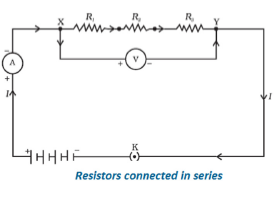
Let there are three resistors are connected in series and their resistances are R1, R2 and R3 respectively.
Let the total effective resistance of the circuit = R
Therefore, As per Law of combination of resistors in series
R = R1 + R2 + R3 ------(a)
How resulting resistance of electric circuit becomes equal to sum of the resistance connected in series?
Let potential difference across the resistance R1 = V1
And the potential difference across the resistance R2 = V2
And the potential difference across the resistance R3 = V3
Let the total potential difference across the electric circuit = V
And, let the total resistance of the circuit = R
Let, electric current flows through the circuit = I
Since, potential difference across the two ends of the circuit is divided among the resistors connected in series.
Therefore, total potential difference across the two ends of the circuit, (V)
= Sum of the potential difference across the ends of each of the resistance
Or, V = V1 + V2 + V3
We know that, according to Ohm's Law
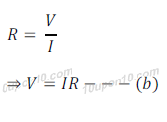
Since, there is no division of electric current when resistance are connected in series, therefore electric current flows through each resistance will be equal.
Therefore, electric current equal flowing through each of the resistance = I
Therefore, V1 = I x R1
And, V2 = I x R2
Similarly, V3 = I x R3
Now, from equation (a) and (b)
V = (I x R1) + (I x R2) + (I x R3)

Now by substituting the value of V = IR, we get
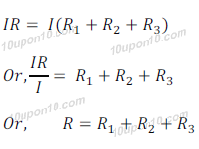
Total Effective resistance when n resistances are connected in series
Let resistances R1, R2, R3 , ..........., Rn are connected in series in an electric circuit.
Let potential difference across the resistance R1 = V1
And the potential difference across the resistance R2 = V2
And the potential difference across the resistance R3 = V3
.............................
Similarly, the potential difference across the resistance Rn = Vn
Let the total potential difference across the two ends of electric circuit = V

Let the electric current flows through the circuit = I
According to Ohm's Law
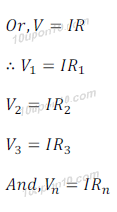
Thus, by substituting the value of V and V1, V2, V3, …… Vn in the equation V = IR, we get
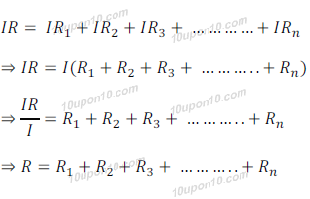
Thus, the total effective resistance of the electric circuit is equal to the sum of all the individual resistance connected in series in an electric circuit.